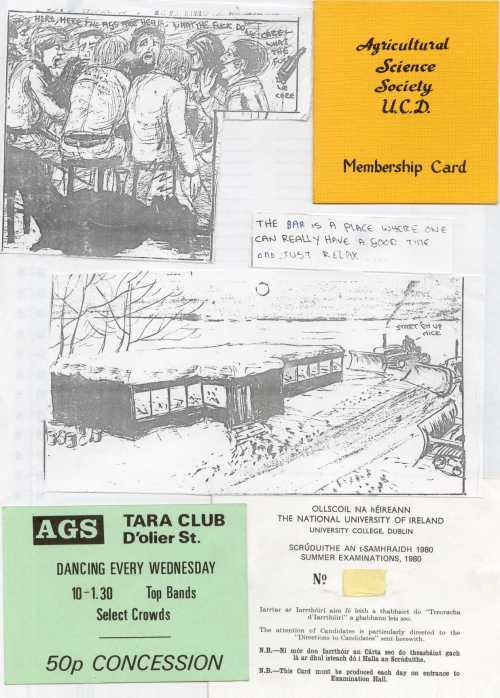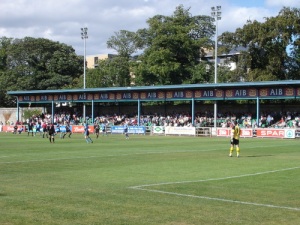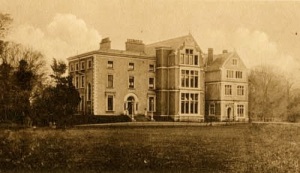Great find. Dermott Hayes interviews UCD Student Bar legend Seamus Boylan about the 1988 Fresher’s Week and they look at what has changed from Hayes’ days there in the 1970s.
Recent Comments
Great find. Dermott Hayes interviews UCD Student Bar legend Seamus Boylan about the 1988 Fresher’s Week and they look at what has changed from Hayes’ days there in the 1970s.
Posted in Miscellaneous History
Great discussion. Politics, comedy, lectures, music and the general life of 1970s Belfield all feature.
Characters in Conversation: Stembridge and Dungan reminisce about 1970s Belfield
For young lads from Limerick and Meath, the Belfield of the 70s was packed with Friday night debates, student societies, classes chosen because they weren’t at 9 am, bedsit living and 2-bar heaters, avoiding SRC meetings, and the Canterbury Tale…
Listen to Gerard Stembridge and Myles Dungan reminisce on their undergraduate days in “the new” Belfield campus of the 1970s as part of Characters in Conversation.
Listen here.
Posted in Miscellaneous History
Thanks to John for sending in these pictures. If you have any pictures or memorabilia from your time in UCD, send it to ucdhiddenhistory(at)gmail.com. Please!
A brief word from John on the background to the protest:
We called the demo because the UCD Authorities were slow in opening the ‘New’ Ag Block as they had promised. Due to that, 3rd & 4th year Ag students used to have most of their lectures in The Albert College (Now DCU) up until May 1979. The march left from The Albert, went down through O’Connell St past TCD, Leeson St , Ranelagh, Clonskeagh into Belfield in March 1979. The New Block opened in the Autumn of 1979. We qualified in 1980 and there was a large lack of jobs back then also

a) Cartoon of Ag students singing in bar. b) Ag science society UCD membership card. c) Cartoon of student bar. d) AGS flyer for Wednesday dance. e) UCD Summer Exams 1980 notice
Posted in Miscellaneous History, Radical History
An interesting find on the British Pathe site! A 60second clip of UCD students outside Earlsfort Terrace performing a “skit” on the Ku Klux Klan during Rag Week in the 1930s/40s (?).
Click the image below to see the full movie.
Posted in Miscellaneous History
Tagged earlsfort terrace, kkk, ku klux klan, Rag Week, UCD
Many thanks to John O’Dowd for spotting the above reference in The Irish Times.
He even got in contact with Aidan Grannell, Head of Buildings and Services, who retrieved the old estate maps of Belfield. Through these they was able to discover that the Twelve Apostles’ Well is buried pretty much dead centre under the dual carriageway, opposite the Montrose Hotel.
Conor James McKinney from T.C.D. Miscellany has very kindly sent me on a very interesting article that was written in the magazine in 1962 by Anthony Clare about the censorship regime in UCD at that time.
You should be able to read it by clicking the picture below and zooming in.
Posted in Miscellaneous History
Tagged censorship, earlsfort terrace, tcd miscellany, UCD
Debunking the intriguing claim that Sócrates played for the UCD Reserve team in the 1970s.
The origins of this long established urban legend are hazy. However, the basic ‘facts’ of the story are as follows: Sócrates, the famous Brazilian soccer player, studied medicine in Dublin in the late 1970s and during his time here played for the reserve team of University College Dublin (UCD).
There are many variations of the story with some placing Sócrates at the Dublin Institute of Technology (DIT) or even the Royal College of Surgeons (RCSI).
It’s a feel good anecdote that has been doing the rounds for at least three decades. The story is so quirky and original that most people take it at face value and it’s turned up as a question on many a table quiz.
An article in The Irish Times from 1986 is the earliest known reference to this alluring tale. It states as fact that Sócrates played for Shelbourne Football Club during his time studying in the “College of Technology, Kevin Street”. [1]
It should be said that Sócrates did indeed study medicine while in college but he graduated from the ‘Faculdade de Medicina de Ribeirão Preto’ in São Paulo.
In 2000, the urban legend was given a new breath of life after a question was sent into the Guardian’s soccer ‘Knowledge Department’. The newspaper was asked to investigate the claim that “Brazilian footballer Sócrates … spent some of his student years in Dublin … and (that) he only managed to make the UCD reserve team”. [2]
The question was answered by the late Brendan McKenna, former Football Association of Ireland (FAI) Press Officer, who confirmed that “Sócrates did play for UCD … sometime in the 70s.” and by Gerry Callan of The Irish Star who added that Sócrates played only for the reserves because he couldn’t make the first team’s Saturday games.

Sócrates in Fiorentina colours.
The Guardian gave the story yet more veracity in 2002 by incorporating new information from a reader that Sócrates quit the team after only “a couple of games because the coach and manager at the time, Dr Terry O’Neill, insisted that he quit smoking”. [3] The Mirror also ran a story on Sócrates during this time with the opening line, “Here’s one to stump your mates with. Which Brazilian legend played football for UCD reserves?”.[4]
The programme for the UCD – St. Patrick’s Athletic game in 2003 featured an article on the Sócrates tale.[5] It debunked the claim that he played for UCD but went on to allege that Sócrates studied medicine in the Royal College of Surgeons of Ireland (RCSI) in 1976. The article also asserted that he went to the RCSI’s trials for their Collingwood Cup team but decided to concentrate on his studies instead after seeing the poor football abilities of his potential teammates.
The China Daily, an English Language newspaper published in the People’s Republic of China, ran an article in 2006 that described Sócrates as “an alumni of the College of Surgeons in Dublin”. [6]
The legend has recently been given new legs by the addition that Sócrates also won the Sigerson cup, the championship of Higher Education Gaelic football in Ireland. This allegation has been posted as fact on various Irish sport Internet forums.
The Sunday Tribune in 2006 did its best to sink the urban legend with the article “Will Sócrates Myth Ever Be Put To Bed?” [7] and in its 2008 Sports Trivia Christmas Quiz. [8] But with websites such as Footbo.com, still affirming that Sócrates “spent time in Ireland and turned out for the University College Dublin (UCD) team”[9] ; the legend isn’t going anywhere soon.

Belfield Park (1971-2007)
Billy McGrath, who played first team soccer for UCD from 1973 to 1977 (and later for a short time with Pegasus, UCD’s graduate soccer team), can confirm that Sócrates never played for UCD – “At the time the UCD first team was playing in the League of Ireland B division so if he was playing for UCD – and not good enough for the first team – he would have been in the Leinster Senior League”. [10]
(But what would Billy know? He was probably too busy watching Pele play hurling for Na Fianna in Ballymun during the Brazilian’s time studying marketing in DCU in 1975-1977. The reality that the college did not exist at the time has no bearing on the facts.)
So there you go. Unfortunately, there is no basis whatsoever to the legend that Sócrates played for UCD and it is just too good to be true. Sócrates has himself admitted that he hasn’t even visited Dublin!
–
[1] Peter Byrne, “World Cup Stars Played in League”, The Irish Times, June 3 1986
[2] Sean Ingle, “Knowledge Unlimited”, The Guardian, 13 September 2000
[3]Sean Ingle and Scott Murray, “Shooting from the hip”, The Guardian 10 January 2002
[4] James Morgan, “The Great Philosopher; A doctor who smoked 20-a-day and led a player’s revolt, Socrates truly was the thinking man’s footballer.” The Mirror, May 27 2002
[5] http://foot.ie/forums/showpost.php?p=380588&postcount=28
[6] Anon, “Smoke on the bench not music to FIFA’s ears”, China Daily, June 15 2006
[7] Enda McEvoy and Kieran Shannon, “Will Socrates Myth Ever Be Put To Bed?, Sunday Tribune, April 16, 2006
[8] Enda McEvoy, “Enda McEvoy’s Really Cool Sports Trivia Quiz”, Sunday Tribune, December 21, 2008
[9] Sócrates Brasileiro Sampaio de Souza Vieira de Oliveira Biography, http://www.footbo.com/Players/Socrates_Socrates/Biography (Accessed 15 June 2009)
[10] Billy McGrath, email to author, 15 June 2009
Posted in Miscellaneous History
A new book that “charts the rich and varied experiences of thirty four very different students across that decade”.
Trinity Tales: Trinity College Dublin in the Sixties.
Edited by Sebastian Balfour, Laurie Howes, Michael de Larrabeiti, Anthony Weale.
The Lilliput Press, 271pp. €20
Irish Times Review: http://www.irishtimes.com/newspaper/weekend/2009/0620/1224249165095.html
Buy it online at the Trinity Library Shop: http://www.tcd.ie/Library/Shop/product.php?productID=2183
Posted in Miscellaneous History
A brief look into the history of Richview Lodge which from 1885-1980 was a Masonic Boys’ School.
Richview Lodge in Clonskeagh, where the UCD School of Architecture is now based, was built in 1790 by the Powell Family.

Early view of Richview Lodge
In 1885 it was bought by the Freemasons of Ireland and developed into a Masonic Boys’ School, which only closed its doors in 1980.[1] Various freemasonry symbols can still be seen in and around the building today.
The school, which moved from Adelaide Hall because of overcrowding, was founded to “provide for the education and maintenance of the sons of deceased members of the Masonic Order” .[2] Sir Thomas Drew extended the school in the late 1880s. Drew was one of the most distinguished Irish architects of the 19th century. He was responsible for designing the Ulster Bank on Dame Street, Rathmines Town Hall, the Trinity College Graduate’s Building and St. Anne’s Cathedral in Belfast.[3]
A trawl of The Irish Times archive showcases dozens of articles from the late 1800s regarding the annual “Masonic Orphan Boys School Sports” days, which became an extremely important date on the Irish sports calendar. The 1890 Sports Day boasts of “military bands and day light fireworks” – tickets were only a shilling each with Family Tickets (admitting three) on sale for only two shilling “provided they (were) applied for at the Freemasons Hall on Molesworth Street”. [4] In 1891, there were over two-dozen different competitions including a “one mile walking race”, “throwing the cricket ball” and a “sack race”.[5] A Clay Pigeon Tournament was held in 1893 to raise funds for the school[6] , the following year The Band of the Royal Dragoons played “a selection of music” on the grounds. [7]
The school was in the news in 1904 when Prince Arthur, Duke of Connaught (Queen Victoria’s son) and his wife Princess Louise of Prussia visited the school. The royal party were given a tour of the grounds, inspected the ninety boys enrolled in the school and had tea.[8] Prince Arthur was himself a Freemason and was elected Grand Master of the United Grand Lodge of England thirty seven times, the last when he was eighty-nine.
In 1930, the school built “an infirmary and hall” in memory of the pupils of the school who fought and died in the First World War. [9]

WW1 Memorial Plaque
In 1944, a memorial pavilion (at the cost of £820) was built in memory of Mr. James Moore, who had been headmaster of the school from 1896-1940. [10] In 1969, a new £60,000 science block was added to the school and named the ‘Raymond F. Brooke Memorial Building’ honouring the late Deputy Grand Master of the Grand Lodge of Ireland. [11]
Freemasonry is a fraternal organisation whose origins lie in the stonemasons’ guilds of the Middle Ages. Membership is only open to men, of legal age who believe in a “supreme being”.
The Grand Lodge of Ireland is the second oldest in the world with the first evidence of its existence coming from a mention in the Dublin Weekly Journal in 1725. [12] In the thirty-two counties today, there are 700 Masonic lodges made up of 35,000 freemasons.
The symbol of the crossed compass and set-square (see below) is the most easily identifiable symbol of Freemasonry. The compass supposedly represents spirituality and divinity (i.e. Heaven); while the set-square is supposed to embody mortality and impermanence (i.e. Earth). According to the Masons, together these symbols embody the union of earth with the heavens, or matter and mind. The Eye of Providence (which sits between the compass and set-square) represents the all-seeing eye of God.

Freemasonry symbol on Richview Lodge
In 1980, UCD bought Richview Lodge and its estate of 17.4 acres for £2.1million. [13] This was provided by the government in consideration of the college’s agreement to vacate part of the Merrion Street Building. Richview Lodge and its surrounding building now accommodates the UCD School of Architecture, Landscape and Civil Engineering.
—
[1]Donal McCartney, UCD: A National Idea, The History of University College, Dublin (Dublin, 1999), 397
[2]Patrick d’Esterre, “Masonic Boys School”, The Irish Times, July 23, 1964.
[3]Architects of Ireland – Sir Thomas Drew (1838-1910) http://ireland.archiseek.com/architects_ireland/drew.html
[4]Anon, “Athletic Sports at the Masonic Orphan Boy’s School”, The Irish Times, July 3, 1890.
[5]Anon, “Masonic Orphan Boys School Sports Annual Sports”, The Irish Times, June 29, 1891.
[6]Anon, “Clay Pigeon Shooting Tournament At Clonskeagh”, The Irish Times, May 5, 1893.
[7]Anon, “Masonic Orphan Boys School Sports Annual Sports”, The Irish Times, June 22, 1894.
[8]Anon, “Masonic Orphan School Clonskeagh, – Visit of the Duke and Duchess of Connaught”, The Irish Times, April 20, 1904.
[9]Anon, “Masonic Orphan Boys School – Memorial Hall and Infirmary Opened”, The Irish Times, June 30, 1930.
[10]Anon, “Memorial to late Headmaster”, The Irish Times, May 1, 1944.
[11]Anon, “New block at Masonic boys’ school”, The Irish Times, May 26, 1969.
[12]Website of the Provincial Grand Lodge of Munster http://www.munsterfreemason.com/Freemasonry_in_Ireland.htm [Accessed 20th April 2009]
[13]Donal McCartney, UCD: A National Idea, The History of University College, Dublin (Dublin, 1999), 397
Posted in Miscellaneous History